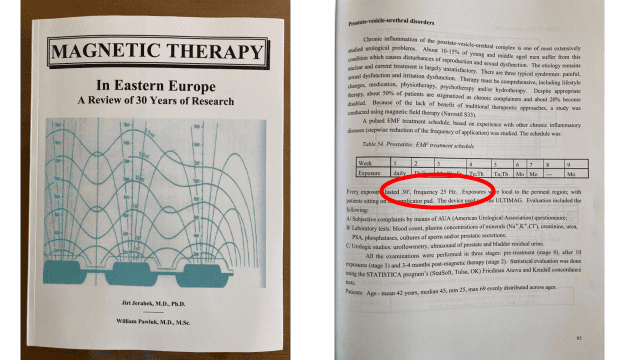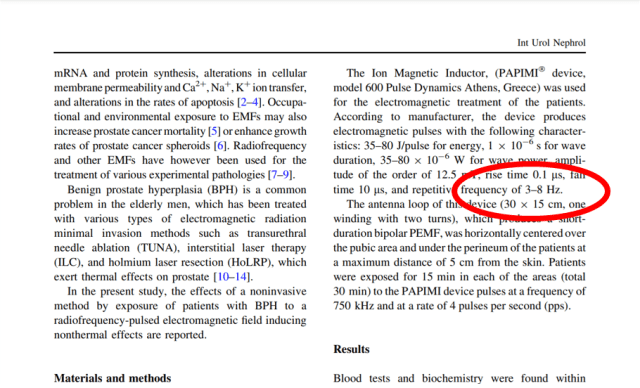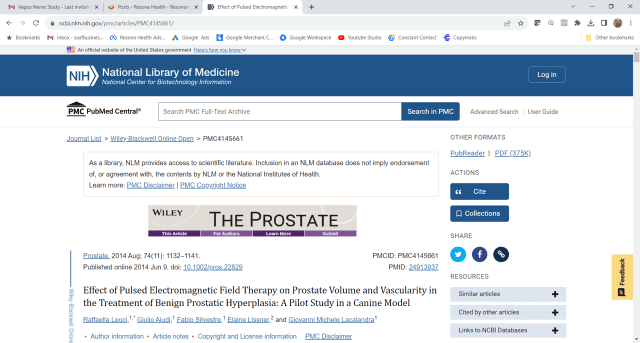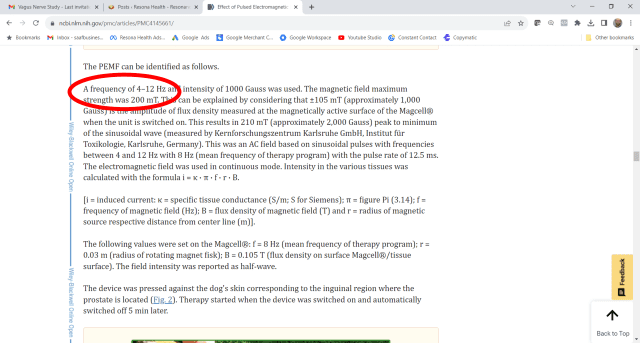For BPH or Enlarged Protsate, we recommend alternating 3 protocols: General Inflammation, Brain Wave Theta, and Brain Wave Beta
Pulsed Electromagnetic Field therapy (PEMF) for Benign Prostatic Hyperplasia (BPH), also known as an enlarged prostate. If you or someone you know is suffering from this common condition that affects millions of men worldwide, then you’ve come to the right place! In this article, we will dive into what PEMF is and how it can potentially provide relief for those dealing with BPH.
What is PEMF?
PEMF, short for Pulsed Electromagnetic Field therapy, is a non-invasive treatment method that has gained popularity in recent years. It involves the use of electromagnetic fields to stimulate and improve cellular function in the body. This technology has been used for various health conditions, including pain management, bone healing, and now even for prostate health.
The principle behind PEMF is based on the idea that every cell in our body has an electromagnetic field. When this field becomes disrupted or imbalanced due to factors such as aging or illness, it can lead to a variety of health problems. That’s where PEMF comes in – by delivering specific frequencies and intensities of electromagnetic fields to targeted areas of the body, it aims to restore balance and promote healing at a cellular level.
When it comes to BPH specifically, PEMF shows promise in helping alleviate symptoms associated with an enlarged prostate. By using specific frequencies like 25 Hz (hertz), which have shown potential benefits for prostate-related issues, PEMF may help reduce inflammation and improve blood flow within the prostate gland. We will expand on the protocols and frequencies in more detail in this article below.
So if you’re looking for alternative options to manage your BPH symptoms without resorting solely to medication or surgery, exploring the potential benefits of PEMF therapy could be worth considering. In the next sections we will delve deeper into how exactly this therapy can potentially help those dealing with BPH and what evidence currently exists regarding its effectiveness.
What is BPH?
BPH, or benign prostatic hyperplasia, is a common condition that affects the prostate gland in men. The prostate gland is responsible for producing fluid that nourishes and transports sperm. As men age, it’s not uncommon for the prostate to enlarge.
When the prostate becomes enlarged, it can cause various urinary symptoms such as frequent urination, weak urine flow, difficulty starting or stopping urination, and a feeling of incomplete emptying of the bladder. These symptoms can significantly impact a man’s quality of life and overall well-being.
BPH occurs due to hormonal changes in the body that cause an increase in cell growth within the prostate gland. While BPH is not cancerous or life-threatening, it does require medical attention to manage its symptoms effectively.
It’s important to note that BPH is different from prostate cancer. Prostate cancer involves abnormal cell growth within the prostate gland and requires separate diagnosis and treatment approaches.
How can PEMF help with BPH?
PEMF, or Pulsed Electromagnetic Field therapy, is a non-invasive treatment that uses electromagnetic waves to promote healing in the body. But how exactly can PEMF help with BPH?
BPH, or Benign Prostatic Hyperplasia, is a condition where the prostate gland enlarges and causes urinary symptoms like frequent urination, weak stream, and difficulty starting and stopping urination. While there are various treatment options available for BPH, some men may be seeking alternative therapies like PEMF.
One way that PEMF can help with BPH is by reducing inflammation in the prostate gland. The electromagnetic waves stimulate blood flow and oxygenation to the area, which can decrease swelling and improve overall prostate health.
Additionally, PEMF has been shown to have pain-relieving effects. Men with BPH often experience discomfort or pain during urination due to bladder obstruction caused by an enlarged prostate. By using PEMF therapy regularly, individuals may find relief from these uncomfortable symptoms.
Moreover, studies suggest that PEMF can potentially inhibit cell growth in the prostate tissue. This could slow down the enlargement of the gland associated with BPH progression.
By incorporating regular sessions of PEMF therapy into their routine along with other recommended treatments for BPH management such as medication or lifestyle changes prescribed by their healthcare provider; men suffering from this condition might notice improvements in urinary symptoms and overall quality of life.
What is the evidence for PEMF and BPH?
Numerous studies have explored the potential benefits of using PEMF therapy for managing symptoms associated with benign prostatic hyperplasia (BPH). While more research is needed to definitively establish its efficacy, early findings are promising.
1 – The VIBE “General Inflammation” protocol
The VIBE “General Inflammation” protocol is used for many, many ailments as general inflammation is the root cause of most ailments. The protocol is unpublished and proprietary, but we will share that it contains a symphony of 12 frequency pairs that range from 9 – 116 Hz.
2 – The VIBE Brain Wave Beta Protocol
The VIBE Brain Wave Beta Protocol is in the 25Hz range so we recommend this protocol as part of the overall BPH therapy based on the Human study below.
One study published in The Journal of Urology investigated the effects of low-frequency PEMF (25 hz) on patients with BPH. The results showed a significant reduction in prostate volume, improved urinary flow rate, and decreased residual urine volume after several weeks of treatment. These outcomes suggest that PEMF may help alleviate some of the bothersome symptoms associated with BPH.

Another study conducted at a university hospital examined how PEMF therapy impacted prostate-specific antigen (PSA) levels in men with BPH. PSA levels serve as an indicator for prostate health, and elevated levels can indicate conditions such as prostatitis or prostate cancer. After receiving regular sessions of PEMF therapy, participants experienced a notable decrease in their PSA levels, suggesting a positive impact on overall prostate health.
Two therapeutic studies recently that lend support to the use of PEMFs to noninvasively, and safely, reduce the size of the prostate. One of these studies is in humans, the other in dogs.
3 – The VIBE Brain Wave Theta Protocol
The VIBE Brain Wave Theta Protocol is in the 4-12Hz range so we recommend this protocol as part of the overall BPH therapy based on the above human and dog studies.
Human Study
In the human study, half of the patients with BPH, aging 68-78 years old were treated with medication for at least 4 weeks, and another group was treated with PEMFs for 2 weeks, for 30 min daily, 5 consecutive days per week. Patients of both groups were evaluated before and after drug and PEMF treatment by values of total PSA, acid phosphatase, ultrasound estimation of prostate volume and residual urine, estimation of urine flow rate, and measurement of an International Prostate Symptom Score (IPSS). There was a significant decrease, before and after treatment, of IPSS (P < 0.02), U/S prostate size (P < 0.05), residual urine (P < 0.05) and urine flow rate (P < 0.05) in the PEMF-treated patients. In contrast, the medication treatment group had only improved IPSS (P < 0.05). There was also a significant improvement in clinical symptoms in patients of the electromagnetic group.


Follow-up of the PEMF treated patients for one year revealed that results obtained by PEMF treatment are still maintained.
Dog Study
The dog prostate is a model for understanding abnormal growth of the human prostate gland. At a different research study, the authors studied the effectiveness of using PEMFs in dogs to modify prostate blood flow and evaluated its effect on BPH. PEMFs were applied, 5 min, twice a day for 3 weeks, on 20 dogs with BPH. A number of measurements were evaluated before and after treatment: prostate size by ultrasound, libido, semen quality, testosterone levels, plasma volume, composition and pH.
The PEMF therapy produced a significant reduction in prostatic volume by an average of 57% in the 4-12 Hz frequencies, without any interference with semen quality, testosterone levels or libido. Doppler ultrasound showed improved circulation. They concluded that this approach would have suitability for the treatment of humans, as seen with improvement of BPH in dogs, with no side effects. It further supports the theory that impairment of blood supply to the lower urinary tract may be a causative factor in the development of BPH.


Conclusion
We have highlighted 3 different studies that shows promise as an adjunctive treatment option for men dealing with BPH symptoms.
From these studies, we recommend a regiment of 3 VIBE protocols for BPH Therapy: General Inflammation, Brain Wave Beta, and Brain Wave Theta. While further research is necessary to establish its efficacy definitively, many individuals have reported positive outcomes when incorporating this non-invasive modality into their overall management plan.



